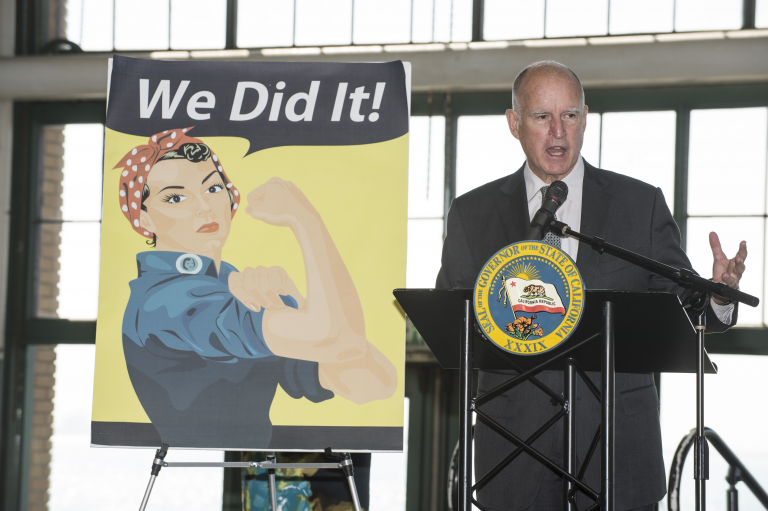-

On May 7, 2016, Ramit Mizrahi will be speaking about the top discovery issues in employment law. The panel, titled “Here we go again! Common discovery issues with no easy answers,” will be part of the Los Angeles County Bar Association Labor & Employment Annual Retreat & Section Meeting.
Date and time: May 7, 2016, 11:30 a.m.
Location: Omni Rancho Las Palmas Resort & Spa, 41000 Bob Hope Drive, Rancho Mirage, California 92270
Additional information can be found on the LACBA website.
-
12 Apr '16

Women earn an average of 79 cents per dollar as compared to their male peers. At that rate, a woman would have to work from January 1, 2015 to today (April 12, 2016) to earn the same amount as her male peer did in 2015!
Equal Pay Day is an opportunity to reflect on the reasons why women still earn less on average than their male peers — and the remedies available to us.
There are many factors that cause women to earn less than their male peers, including sex segregation at work, implicit biases, and penalties that women pay for caregiving.
Fortunately, we are making inroads toward addressing these issues. The Fair Pay Act will hopefully make a tremendous difference in California, as employers are now required to justify any pay disparities between men and women doing comparable work. I expect that as employers scrutinize their pay practices, they will put into place objective criteria that ensure that workers are paid fairly, and will provide equity adjustments to female workers who are underpaid relative to their male peers without justification. The EEOC’s proposal to collect pay data would also shine a light on employers’ pay practices to ensure that there are not unjustifiable disparities in pay among the various protected classes of people.
Other exciting changes are afoot, including moves toward expanding paid leave to workers in San Francisco and New York. As more mothers and fathers have access to paid leave (and are encouraged to take it), women will be less likely to be penalized at work for taking time off for caregiving work (and men will have greater freedom to take leave).
Also exciting is the move toward a $15 minimum wage in California.
While Equal Pay Day is generally not a “happy” day, there is much to be happy about this year!
-

Registration is now open for the State Bar of California’s 33rd Labor & Employment Law Annual Meeting, which will be held at the beautiful Claremont Club & Spa in Berkeley, CA on April 21, 2016. It will be followed by the 22nd Annual Public Sector Conference on April 22, 2016. (You can register for one or both days.)Ramit Mizrahi is honored to be both the Co-Chair and a sponsor of the Annual Meeting, which promises to bring together several hundred of the top California labor and employment lawyers for an excellent educational and networking event. Highlights of the Annual Meeting will include:
- A keynote address by the Hon. Brad Seligman, Superior Court of Alameda County;
- A review of the year’s most significant employment cases;
- A plenary session with Stanford Law Professor Deborah Rhode on The Trouble with Lawyers (and how we can improve satisfaction in the legal profession);
- A plenary session on trial opening statements, presented by two top trial lawyers;
- Concurrent panels covering the following topics: the newest developments in wage and hour law, accommodating mental disabilities in the workplace, the evolving role of NLRB in today’s workplace, ethical issues in employment litigation, comparative law, and workplace retaliation;
- An evening networking reception;
- And much more!
Thursday-Friday, April 21-22, 2016
Claremont Club and Spa
1 Tunnel Road, Berkeley, CA -

An estimated 0.3% of adults are transgender. Many face pervasive harassment, discrimination, violence, and abuse in every aspect of their lives, including at work, in housing, education, healthcare, and personal relationships. Consider the discrimination suffered by transgender individuals at work. According to a comprehensive 2011 report titled “Injustice At Every Turn: A Report of the National Transgender Discrimination Survey“:- 90% of transgender individuals surveyed reported experiencing harassment, mistreatment or discrimination on the job or took actions like hiding who they are to avoid it.
- 47% said they had experienced an adverse job outcome, such as being fired, not hired or denied a promotion because of being transgender or gender non-conforming.
- Over one-quarter (26%) reported that they had lost a job due to being transgender or gender non-conforming and 50% were harassed.
- Large majorities attempted to avoid discrimination by hiding their gender or gender transition (71%) or delaying their gender transition (57%).
- Overall, 16% said they had been compelled to work in the underground economy for income (such as doing sex work or selling drugs).
- Respondents who had lost a job due to bias also experienced ruinous consequences such as four times the rate of homelessness, 70% more current drinking or misuse of drugs to cope with mistreatment, 85% more incarceration, more than double the rate working in the underground economy, and more than double the HIV infection rate, compared to those who did not lose a job due to bias.
- A staggering 41% of respondents reported attempting suicide compared to 1.6% of the general population, with rates rising for those who lost a job due to bias (55%), were harassed/bullied in school (51%), had low household income, or were the victim of physical assault (61%) or sexual assault (64%).
California has protected transgender employees from workplace and housing discrimination since before 2003. It has done so through the Fair Employment and Housing Act (FEHA), which prohibits discrimination, harassment, and retaliation based on certain protected categories. However, many Californians remain unaware that transgender employees are protected from workplace discrimination. To help educate workers and employers, the California Legislature made these protections explicit in 2003 and 2011. And, this week, California’s Department of Fair Employment and Housing issued guidance . . .
-

Thanksgiving is a special time of year where we share time with our loved ones and reflect on the things for which we are most grateful. In that spirit, here are five reasons that California employees can celebrate this year:
1. The California Fair Pay Act
The California Fair Pay Act will take effect in January 2016, dramatically strengthening California’s Equal Pay Act. As I previously discussed in greater depth, the Fair Pay Act will help women receive equal pay for “substantially similar” work (not just “equal work”), including by eliminating loopholes, enacting strong anti-retaliation provisions, and mandating that employers keep pay records for three years. By requiring that employers have legitimate justification for pay disparities, the Fair Pay Act will help narrow the gender pay gap that now leaves women earning a mere 82% of what their male peers earn.
2. Minimum Wage Increases
On January 1, 2016, California’s minimum wage will increase from $9 per hour to $10 per hour statewide. This will raise the minimum compensation needed to be exempt from overtime to $41,600 per year (two times the state minimum wage for full-time employment).
The minimum wage in the City of Los Angeles will increase to $10.50 an hour in July 2016 (with small businesses and nonprofits on a modified schedule), and will then slowly rise until it reaches $15 an hour by 2020. These increases will help lift working families in California out of poverty and will help revive impoverished areas. The movement to raise the minimum wage throughout the State and throughout the country continues!
3. Expansion of “Associational” Retaliation Protections for Family Members
California has strong protections for workers who engage in activity protected under the Labor Code. Employers are prohibited from terminating them, retaliating against them, or taking any adverse actions against them. AB-1509, signed into law in October, provides protections for an employee who is a family member of a person who engaged in, or was perceived to engage in, protected conduct under the Labor Code. It also protects employees from retaliation by “controlling employers” and “client employers” (for example, when a general contractor retaliates against the employee of a subcontractor, or when a client of a labor contractor tells the contractor not to send a certain employee over for retaliatory reasons).
-

On Tuesday, October 6, Governor Brown signed SB 358 (Jackson), the California Fair Pay Act. The Act, aimed at addressing the gender pay gap, will be the nation’s toughest. It seeks to ensure that women are paid equally for performing substantially similar work, and protects employees from retaliation for disclosing/discussing wages or seeking to enforce their rights. Credit goes to Senator Hannah-Beth Jackson (D-Santa Barbara) for authoring the bill, which had wide bipartisan support, and to co-sponsors
Equal Rights Advocates, California Employment Lawyers Association, and Legal Aid Society-Employment Law Center.The Fair Pay Act Strengthens Existing Law
California’s Equal Pay Act, Labor Code section 1197.5, was first enacted in 1949 and revised in 1985. It is similar to the federal Equal Pay Act of 1963. The Fair Pay Act bolsters the California Equal Pay Act in the following ways:
1. It provides for equal pay for “substantially similar work,” not just equal work in the same establishment.
This means that a woman need not hold the exact job as her male comparators to seek equal pay. Instead, the works needs to be “substantially similar work, when viewed as a composite of skill, effort, and responsibility, and performed under similar working conditions.”
2. It eliminates loopholes and limits employers defenses when a wage differential is challenged.
Previously, the following four defenses were permitted:
-

Noe v. Superior Court, 237 Cal. App. 4th 316 (2015)
Noe v. Superior Court, a California Court of Appeal case decided in June, holds that co-employers who are aware that employees are being misclassified as independent contractors, and fail to remedy it, can be held liable themselves. This case confirms that employers cannot get away with treating employees as independent contractors simply by hiring another company to officially employ and pay them.
Anschutz Entertainment Group (AEG), which owns several entertainment venues in Southern California, contracted with Levy Premium Foodservice (Levy) to provide food and beverage services at AEG’s venues. Levy, in turn, entered into a labor agreement with a group of affiliated companies (Canvas) to provide vendors to sell food and beverages at events. Canvas then hired the vendors and treated and paid them as independent contractors. Levy was aware of this, as its Human Resources representative had acknowledged in an email that Canvas only paid the vendors on a commission basis and questioned whether this practice violated wage and hour requirements. Levy also directly hired some of the vendors and classified them as employees.
In 2013, several of Canvas’s former vendors filed a wage and hour class action lawsuit against Canvas, Levy, and AEG for failure to pay minimum wages and willful misclassification as independent contractors in violation of Labor Code section 226.8. Plaintiffs contended that each of the defendants was liable as a “joint employer.”
AEG and Levy filed motions for summary judgment. They argued, . . .
-

If you believe that you were not hired/promoted or were terminated/laid off because of your age, can you still have a case if the person given preference is also over 40?
The short answer is “yes.”
It does not matter that the person favored is also over 40 if he is “substantially younger.”
The Supreme Court in O’Connor v. Consolidated Coin Caterers Corp., 517 U.S. 308 (1996), confirmed that age discrimination can occur even if the person favored is also over 40. In O’Connor, a 56-year-old who was fired and replaced by a 40-year-old sued under the Age Discrimination in Employment Act of 1967 (“ADEA”). The district court granted the defendant’s summary judgment motion and the Court of Appeals affirmed, holding that the plaintiff failed to make out a prima facie case of age discrimination under because he failed to show that he was replaced by someone under the age of 40. The Supreme Court, in an opinion written by Justice Scalia, held that an employee asserting age discrimination need not demonstrate that his replacement was under 40; rather, he must demonstrate that his replacement was “substantially younger.” O’Connor, 517 U.S. at 312. The Court explained:
-

Ramit Mizrahi was honored to speak at the UN Women-L.A. Chapter’s HeForShe event on Sunday, August 23, 2015 in Los Angeles, California. Below are her remarks.
Equality in Work
We are fortunate to live in a society where sex discrimination in employment has been unlawful for over 50 years. Yet we still have a long way to go.
Gender Pay Gap
Consider the gender pay gap. According to research by the Institute for Women’s Policy Research, in 2014, women working full-time were earning 82% of what their male peers were earning. Breaking it down further, the wage gap for black and Latina women is even greater, with black women earning 68% and Latina women only 61% of what men do.
One third of working mothers are single mothers, and a staggering 30% of them live in poverty. It is estimated that closing the gender pay gap would pull half of those families.
Yet, in the past decade, the gender pay gap has narrowed by just 1.5%.
Some Causes
Workplace discrimination and inequality persist in many forms.
Decades ago, workers were regularly subjected to overt discrimination. It was perfectly normal to have Help Wanted sections in the newspaper divided by jobs for men and women. Sexual harassment of female employees was common.
The most egregious forms of sex discrimination, harassment, and abuse still happen to the most vulnerable populations among us. For example,
-

When the Supreme Court recognized last month in Obergefell v. Hodges, 576 U.S. ___ (2015) that the fundamental right to marry applies to same-sex couples, Americans rejoiced. The Court’s opinion reflected the tipping point we have reached as a nation with broad public acceptance of LGBT rights.
But civil rights activists and allies were quick to point out that there is more work to be done. Pundits observed that in some states, a gay couple could be married in the morning and fired from their jobs for being gay hours later. Indeed, LGBT people in many states still lack protections from discrimination and harassment in employment, housing, and education. Sexual orientation discrimination in employment is not explicitly prohibited under federal law. In California, we are lucky to have the Fair Employment and Housing Act, Government Code section 12940 et seq., which has, since 2000, prohibited discrimination and harassment based on sexual orientation in employment and housing. LGBT people in other states have not been so fortunate.
LGBT workers are protected from sexual orientation discrimination under Title VII
Thanks to a landmark decision by the federal Equal Employment Opportunity Commission (EEOC), however, millions more LGBT workers now have some protections. In a July 15, 2015 decision, the EEOC held that sexual orientation discrimination is unlawful under Title VII of the Civil Rights Act of 1964 (Title VII). Title VII applies to employers with at least 15 employees. It prohibits discrimination, harassment, and retaliation based on protected categories, including with respect to hiring, firing, promotions, training, wages, and benefits.
Title VII prohibits discrimination based on sex, race, color, religion, and national origin; it does not explicitly cover discrimination based on sexual orientation. In a 3-2 decision, the EEOC reasoned that sexual orientation discrimination is nevertheless prohibited by Title VII because it is a subset of sex discrimination. The EEOC determined that an air traffic controller who alleged that he was denied a promotion because of his sexual orientation could pursue his claim of sex discrimination. While the 17-page decision is worth reading in full, the excerpts below capture the EEOC’s reasoning.
Mizrahi Law Blog
Mizrahi Law, APC
- 35 N Lake Ave, Ste 710, Pasadena, California 91101
- contact@mizrahilaw.com
- (626) 380-9000
Client Testimonial
“I highly recommend Ramit Mizrahi. She has a winning combination of knowledge, passion, strategy, and empathy. She takes action and communicates updates promptly. Her professionalism is hard to beat. I’d give her 10 stars if I could!”
Latest News
- Ramit Mizrahi has been recognized as one of the Top 100 Super Lawyers and Top 50 Women Super Lawyers in Southern California in 2023.
- Ms. Mizrahi is being recognized in the 2023 Edition of The Best Lawyers in America©, published by U.S. News & World Report and by Best Lawyers.
- Ms. Mizrahi has been selected as a Top Attorney by Pasadena Magazine for 2023.
- Ms. Mizrahi is serving as Chair of the Pasadena Bar Association Labor and Employment Section.
